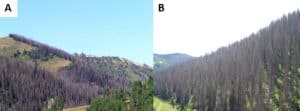A new partnership between Idaho Fish and Game and PotlatchDeltic will provide and preserve public access for hunting, fishing and trapping on 567,002 acres of private land in Benewah, Clearwater, Idaho, Latah and Shoshone counties through a lease agreement.
A second agreement expected to be finalized by early June is with a group of forestland owners and managers, including Stimson Lumber Co., Hancock Forest Management and Molpus Woodlands Group, to allow public access to more than 300,000 acres in Bonner, Boundary, Benewah, Shoshone and Kootenai counties.
Fish and Game will pay $1 per acre annually for the access, which includes hunting, fishing, trapping, wildlife viewing, hiking and recreational travel limited to motor vehicle travel on roads open to full-sized vehicles. Restrictions on camping and ATV use may apply depending on the landowner’s rules.
“These agreements demonstrate Fish and Game’s continued commitment to putting money from the access/depredation fee to good use and provide hunters, anglers and trappers with access to private lands while compensating landowners for their support of those activities,” said Sal Palazzolo, F&G’s Private Lands/ Farm Bill Program Coordinator.
“PotlatchDeltic is pleased to partner with Idaho Fish and Game on this public access agreement. As the largest private timberland owner in Idaho, we recognize the importance of public access for recreational activities and the benefits for sportspersons and outdoor enthusiasts,” said Darin Ball, Vice President Resource, PotlatchDeltic.
The agreements came through Fish and Game’s new “large tracts” land lease program that targets multi-year access to parcels 50,000 acres or larger.
Lease agreements with all the companies will automatically renew for at least three years. Money for the leases comes from House Bill 230, which in 2017 established Fish and Game’s access/depredation fee that requires a $5 surcharge for residents and a $10 surcharge for nonresidents when they buy their first annual license of the year.
The access/depredation fund also pays for continued public access to 2.3 million acres of Idaho Department of Lands state endowment lands for hunting, fish, trapping and other recreation, which includes about $300,000 annually to the Department of Lands and Fish and Game providing law-enforcement services on endowment lands.
Fish and Game’s sportsman’s access programs also includes Access Yes!, which pays landowners to allow the public on, or through, their lands, and parcels accepted into that program go through an annual competitive bid process.
People with questions about the specifics of the PotlatchDeltic agreement can contact Fish and Game’s Private Lands/ Farm Bill Program Coordinator Sal Palazzolo at [email protected], or call (208) 287-2752.
